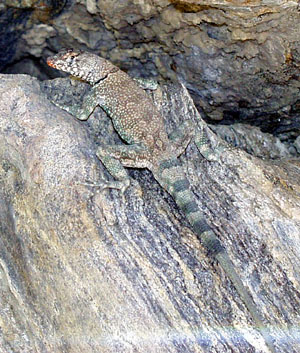Banded rock lizard facts for kids
Quick facts for kids Banded rock lizard |
|
|---|---|
 |
|
| Conservation status | |
| Scientific classification | |
| Genus: |
Petrosaurus
|
| Species: |
mearnsi
|
| Synonyms | |
|
|
The banded rock lizard, also known as Petrosaurus mearnsi, is a cool type of lizard. It belongs to a family of lizards called Phrynosomatidae. You can find this lizard living in parts of western North America.
Contents
Why is it Called Mearnsi?
The second part of its scientific name, mearnsi, honors an American naturalist named Edgar Alexander Mearns. He was the first person to collect samples of this lizard.
Where Does it Live?
This lizard is special because it only lives in a few places. You can find P. mearnsi in the very southern parts of California in the United States. It also lives in Baja California, Mexico. There's even a small island called Isla El Muerto where it makes its home.
What Does it Look Like?
The banded rock lizard has a really flat body. Its back can be olive green, brown, or gray. It often has cool white or bluish spots.
It has a single black band around its neck. Its tail has bands, almost like stripes. The scales on its body feel bumpy, but the scales on its tail and legs are ridged.
These lizards can grow to be about 6.2 to 8.7 centimeters (2.4 to 3.4 inches) long from their snout to their vent (the opening at the base of the tail). Male lizards usually have brighter blue colors and more detailed patterns on their throats than females.
What Kind of Home Does it Like?
P. mearnsi loves to live on hillsides with lots of big rocks and boulders. In Baja California, it also lives in areas with chaparral (a type of shrubland) and pinyon-juniper woodlands (forests with pine and juniper trees).
What Does it Eat?
This lizard is an omnivore, which means it eats both plants and animals. It enjoys munching on insects and spiders. But it also likes to eat plant parts like buds and flowers.
How Does it Have Babies?
Female banded rock lizards lay eggs. They usually lay their eggs between June and August. A female can lay anywhere from 2 to 6 eggs at one time. This group of eggs is called a clutch.


